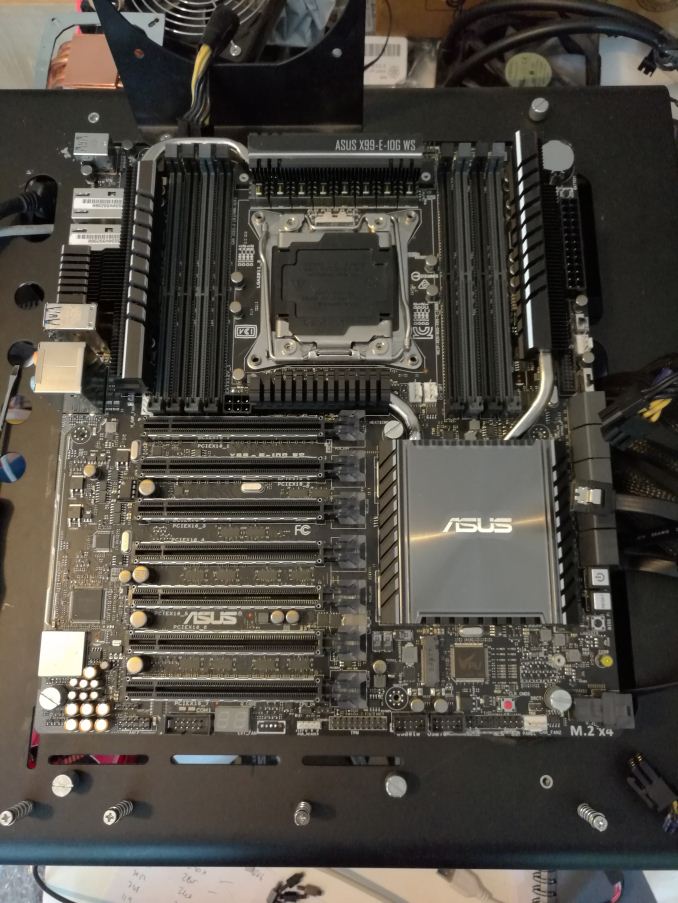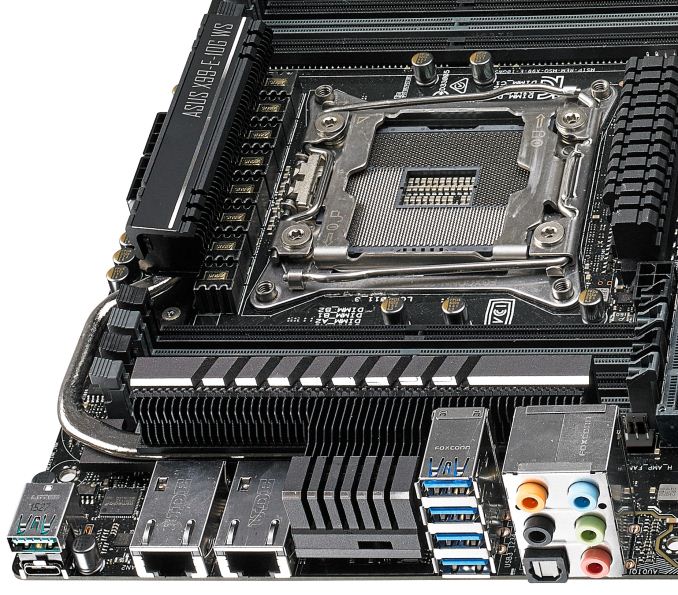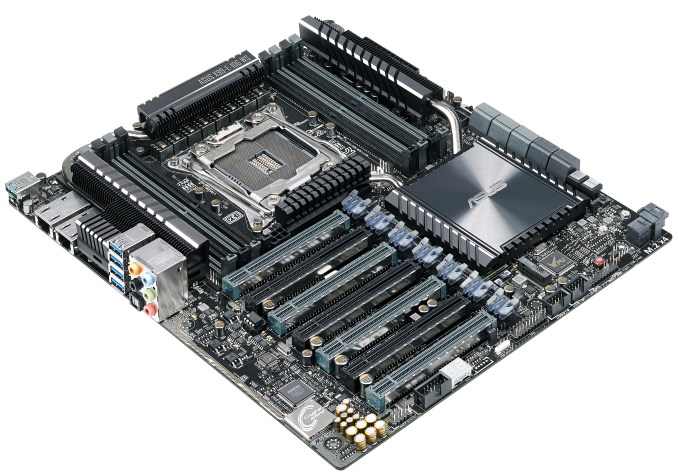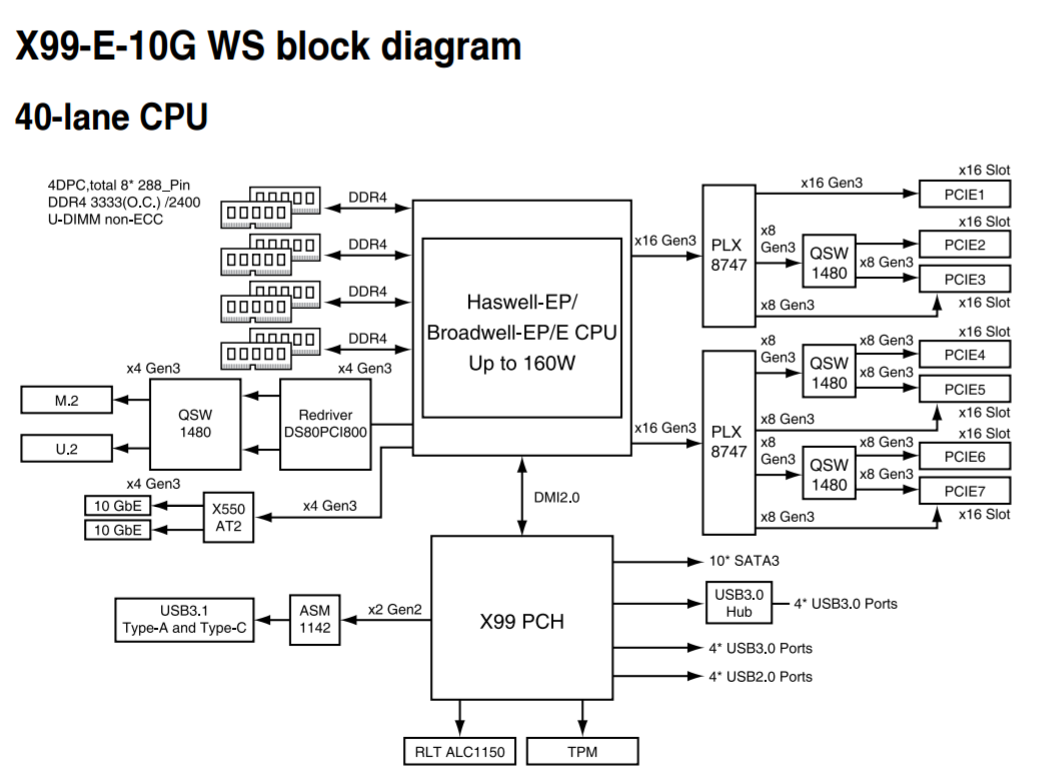ASUS X99-E-10G WS Motherboard Launched: Dual 10GBase-T Ethernet via an Integrated X550-AT2
by Ian Cutress on August 29, 2016 5:20 PM EST- Posted in
- Motherboards
- Asus
- Workstation
- Enterprise
- X99
- 10GBase-T

When we wrote up our list of 10GBase-T capable consumer motherboards back in July, we noted that out of the two main ways to get 10GBase-T on a motherboard, either by and add-in card or via an integrated controller, only one example of the latter existed on the market. For almost two years, that sole motherboard has been the only integrated solution – since then, ASUS launched the Maximus VIII Assembly which comes with a single port add-in card, and we saw a micro-ATX C236 model with a single port from MSI at Computex. We also listed the X99-E-10G WS from ASUS, a new board set to come to the market and we had an early sample. We’re still testing the board, but ASUS is officially announcing it today.
The X99-E-10G WS is built like a brick outhouse, with the focus on premium workstation parts and the latest set of features ASUS could put together while still under the X99 chipset banner, rather than a Xeon chipset. The board is designed for any Broadwell-E CPU, either consumer i7 or Xeon E5 v4, with extensive heatsink arrangements to carry both the Intel X550-AT2 controller (11W), the chipset, the upgraded power delivery and additional controllers.
The main feature is obviously the 10GBase-T ports, which are RJ45 compatible with most home and SMB networks. The X550-T2 controller is a PCIe 3.0 x4 part, which is an upgrade over the older X540-T2 generation that needed PCIe 2.0 x8 (and even at PCIe 3.0, you still needed 8 lanes due to controller limitations). This controller has a list price on Intel’s ARK of $80 for batches of 1000, however it probably adds nearer $100-$150 to the motherboard cost paid for by the end user. Alongside the Ethernet ports are a pair of 10 Gbps USB 3.1 ports (one Type-C), four USB 3.0 ports and the audio.
The board has full support for PCIe graphics, using dual PLX8747s as high-end PCIe switches. This allows support of x16/x16/x16/x16 slots (or x16/x8/x8/x8/x8/x8/x8) while also having enough bandwidth for the X550-T2 controller, a U.2 connector running at PCIe 3.0 x4 as well as an M.2 slot also at PCIe 3.0 x4. The PCIe slots have two additional features, with integrated guard rails in each of the slots to increase rigidity and reduce RMAs, but also the PCIe latches are translucent. When the system is turned on, the main PCIe slot connectors have a LED light that implements a slow breathing effect. Speaking with the motherboard product managers, it turns out that users do not often know which PCIe slots are suitable for maximum bandwidth, and this is designed to help.
The ASUS X99-E-10G WS also comes with 10 SATA 6 Gbps ports, dual USB 3.0 onboard headers, Dr. Power, BIOS Flashback, EZ XMP and an upgraded audio solution. ASUS expects the board to land with an MSRP of $650 with select authorized resellers and distributors soon.
Source: ASUS Edge Up




















40 Comments
View All Comments
ZeDestructor - Tuesday, August 30, 2016 - link
You can plug a Xeon and ECC memory in an X99 board just fine. If the UEFI is built right, it'll even enable the ECC functionality and work fine.Source: put an E5-1630v3 and 4x8GB of Registered DDR4-2133 in an Asus X99-A. The shipping UEFI worked fine, but the ECC functionality was deactivated. One UEFI update later to the latest (something like version 04xx to 12xx) and ECC was fully enabled according to AIDA64 on windows.
kgardas - Tuesday, August 30, 2016 - link
Asus specifies clearly in the board description that non-ECC RAM should be used. If Asus tells this clearly I'm afraid nobody puts any hope into Asus releasing the right UEFI for the board which would magically switch ECC feature on. If Asus does not care about this, I don't have problem with it and go and purchase board from another vendor since other vendor may care and clearly state that ECC RAM is supported and if it is and I do have any issue with this support then I can use warranty to solve this or return the board which I can't in case of Asus since the feature is not advertised nor officially supported. I simply like to have workstation board and supported by the vendor. I'm not interested in gaming boards...alexdi - Tuesday, August 30, 2016 - link
For a do-everything gaming workstation, it's tough to choose between ECC and overclocking. I don't think it's an oxymoron to want both, though like you, I'd probably opt for ECC. And IPMI for that matter; my desktops tend to become servers over time.Come to think of it, who's the target user for this board? It seems like an engineering exercise in overkill rather that the best option for any particular purpose.
JoeyJoJo123 - Tuesday, August 30, 2016 - link
Care to provide a link on this supposed board description?___________________
https://www.asus.com/Motherboards/X99-E-10G-WS/spe...
Memory
8 x DIMM, Max. 128GB, DDR4 3333(O.C.)/3200(O.C.)/3000(O.C.)/2800(O.C.)/2666(O.C.)/2400(O.C.)/2133 MHz Non-ECC, Un-buffered Memory *1
8 x DIMM, Max. 128GB, DDR4 2400/2133 MHz ECC, Un-buffered Memory *2
8 x DIMM, Max. 128GB, DDR4 2400/2133 MHz ECC, Register Memory *2
...
*1 When installing Intel® Socket 2011-v3 Core™ i7/i7 X-Series Processors
*2 When installing Intel® Xeon® E5-2600/1600 v4/v3 Processor
___________________
As far as I can tell, it supports ECC with Xeons and non-ECC for the enthusiast platform chips, and that's standard fare for just about any 2011-v3 socket motherboard I can name.
kgardas - Wednesday, August 31, 2016 - link
Oops! I stand corrected! And thanks for the lesson. :-) I just used description provided by the article and not searched for it on Asus site. Good, if they officially support ECC and their BIOS is up to line and enable it too, then indeed, this may be called workstation board without shame. Thanks!The_Assimilator - Tuesday, August 30, 2016 - link
The cost and power consumption of these 10GbE chips are going to keep them out of the mainstream for a lot longer.atomt - Tuesday, August 30, 2016 - link
Doesnt help that this is a very bling bling board - 10G is not the only thing adding to the cost on this thing. Even some server boards with two sockets and 2x10G are cheaper than this one.ludikraut - Tuesday, August 30, 2016 - link
Now if I could only get this motherboard with built-in SPF+ connectors instead of RJ-45's, I'd be waiting with CC in-hand. To those that believe 10G is unnecessary, anytime you have data transfers between systems equipped with SSDs, 1G ethernet is a significant bottleneck. Although, 10G is overkill for most scenarios. In the testing I've done, the most I was able to get was right around 900MB/s (that's bytes, not bits, an entire DVD in around 5 seconds, lol), with about 700MB/s sustained for large transfers. That was about 2 years ago. I'm sure some of the newer SSD drives will outperform that.atomt - Tuesday, August 30, 2016 - link
Looks like a good board, but personally I'd like to see a less bling-y version with 10G on it. It is not helping the price with expensive PLX chips and whatnot. 10G with PCIe shifting down to x8/x8/x8/x8 when needed (it's plenty!), yes please.Avlin - Monday, September 26, 2016 - link
Milfboard...More seriously they did achieve near perfection !
Today with 1Gbit/s broadband, TB and TB of data, Neural Network or Coin mining, you reach a step where that kind of motherboard makes sense.
If someone says he cannot afford it, I would say go learn any programing language so that you can both afford a card like that but also use it more deeply. When I do web crawling at 1gbi/s + gpu data mining, I would say a 700€ card (900 including VAT :( ) is cheap with so much features !
Even with my old high end rig (2013), I need to reconsider a new rig because my new broadband